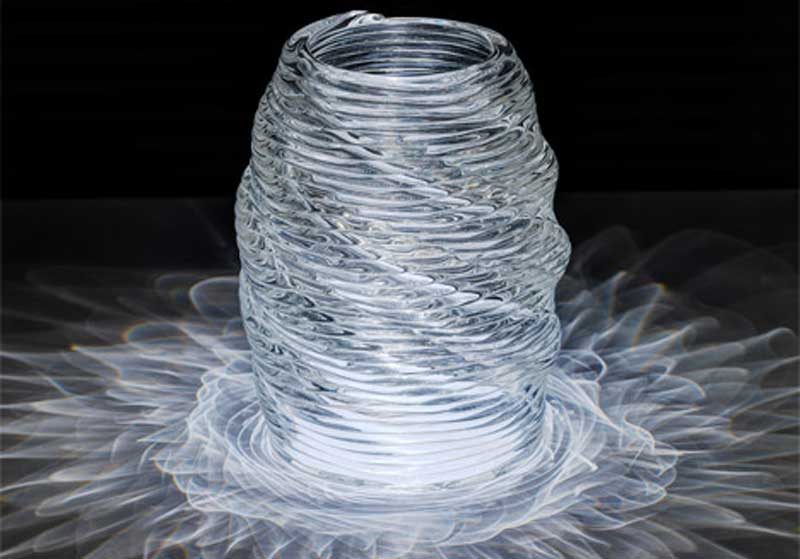 NEWS
NEWS
 NEWS
NEWS
 NEWS
NEWS
Recent innovations in 3D printing continue to reach the market as the concept of producing objects from different materials continues to innovate. In the news right now, MIT has built a 3D printer that can print with 10 different materials at once called the 3D multifab printer. If that wasn’t enough, MIT’s Department of Mechanical Engineering and MIT’s Glass Lab collaborated recently with the Mediated Matter Group to produce 3D prints with kiln melted, molten glass.
Even with modern 3D printers, it’s still only possible to produce a 3D print with one or two materials at once–especially easier with models of 3D printers that use two extruders at once–but the idea of printing with 10 separate materials took the high-powered knowhow of scientists and engineers at the Massachusetts Institute of Technology (MIT).
Using off-the-shelf components, researchers at the school’s Computer Science and Artificial Intelligence Laboratory (CSAIL) were able to build the prototype for less that $7,000–which is on par with some of the more expensive consumer-grade 3D desktop printers on the market.
This means that this sort of 3D printing may in fact become quite affordable in the future.
The MultiFab 3D printer uses inkjet technology to spray microscopic particles into place. The particles are a photopolymer that hardens when subjected to light–in this case UV light.
Photopolymers are also used in stereolithography, such as with the Autodesk Ember 3D Printer. Although these printers require a vat of the photopolymer liquid and work by making the top layers while pulling the printed object out of the vat (the opposite of the more common extrusion printers.)
By using the inkjet technology to spray the photopolymer into place and then shining the UV light onto it to harden it in place means it will operate by printing from the bottom up.
The MultiFab system also uses specialized machine vision 3D scanning techniques to self-calibrate and correct according to what the system could see as it prints. This allows for during-run error correction–and, interestingly, also the possibility for other objects to be embedded into the print (using the specialized software to mask those components out) in the midst of a print.
“The platform opens up new possibilities for manufacturing, giving researchers and hobbyists alike the power to create objects that have previously been difficult or even impossible to print,” said Javier Ramos, a research engineer at CSAIL who co-authored the paper with members of professor Wojciech Matusik’s Computational Fabrication Group.
The researchers at MIT believe that this 3D printing technique could be used for a broad spectrum of consumer electronics applications, microlensing, medical imaging, and telecommunications. This system could be used to produce embedded chips in smartphone cases, watch bands for wearables, and other situations.
These techniques could also be applied to embedding electronics, motivators, motors, and actuators, which would be useful in making robots–especially smaller, flexible robots.
GLASS from Mediated Matter Group on Vimeo.
Developed by the Mediated Matter Group at the MIT Media Lab in collaboration with the Glass Lab at MIT a new 3D printer now exists that can print with molten glass. Not exactly something that will be coming soon to the desktop—or the everyday enthusiast—but it’s a material never-before used for 3D printing.
The system does what is dubbed Additive Manufacturing of Optically Transparent Glass and the machine that executes this task is called G3DP.
The G3DP is designed to print transparent glass with the ability to tune for “geometrical and optical variation driven by form” as well as color variation. Due to this, the 3D printing technique can be used to produce all manner of light-affecting systems using lensing, prisms, reflection, refraction, and so on. Researchers believe this therefore has significant implications for all things glass.
The platform prints from an upper chamber that acts as a Kiln Cartridge and the lower structure is where the 3D model is printed. The Kiln Cartridge operates at approximately 1900°F. To sustain such heat, the extrusion nozzle is made of alumina-zircon-silica.
“Initial efforts are being conducted to test how the technology could be utilized to manufacture an architectural system from printed glass components,” Mediated Matter told ArchDaily. “The advantages with 3D printing are in the expanded design space, the ability to achieve customization, and the fact that design complexity can be achieved. Glass can be distributed in a more sophisticated way throughout the cross section of each component, and intricate inner features are feasible which enable the incorporation of internal channels to distribute water, air and other biological mediums.”
A selection of 3D printed glass structures will be exhibited at Cooper Hewitt, Smithsonian Design Museum in 2016.
The G3DP project was created in collaboration between the Mediated Matter group at the MIT Media Lab, the Mechanical Engineering Department, the MIT Glass Lab and Wyss Institute. Researchers include John Klein, Michael Stern, Markus Kayser, Chikara Inamura, Giorgia Franchin, Shreya Dave, James Weaver, Peter Houk and Prof. Neri Oxman.
THANK YOU